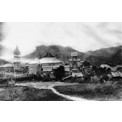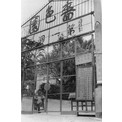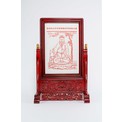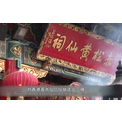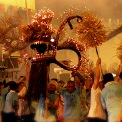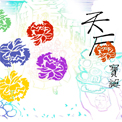 Collections
Collections The Oral Legacies (I) - Intangible Cultural Heritage of Hong Kong
The Oral Legacies (I) - Intangible Cultural Heritage of Hong Kong Wong Tai Sin Belief and Customs
Wong Tai Sin Belief and Customs The Origin of the Folk Religion
The Origin of the Folk Religion
The folk religion of Wong Tai Sin in Hong Kong can be traced back to folk religious activities that sprang from adherence to the Taoist xianren (human who has attained immortality) Huang Chuping. The earliest account of Huang was recorded in Ge Hong’s Biographies of the Immortals in the Eastern Jin period. From the Eastern Jin to the Qing dynasty, Wong Tai Sin developed into one of the folk religions in the Jinhua region in Zhejiang Province as Huang Chuping was worshipped as a Taoist immortal that possessed magical healing powers and controlled precipitation. During the Ming and Qing dynasties, the Wong Tai Sin folk religion spread to South China and had become prevalent in Guangdong by late Qing dynasty.
In 1915, Liang Ren’an and Liang Junzhuan, father-son Wong Tai Sin adherents and Taoist practitioners in the Po Hing Tan (altar) in Xiqiaoshan, Guangdong, fled from military conflicts at home to take refuge in Hong Kong. They set up an altar in Central District to proselytise. The foundation of the Wong Tai Sin folk religion in Hong Kong was probably laid there and then. In 1921, Liang founded the “Tsik Chung Sin Koon” in Chuk Yuen Village, Kowloon City, as a private temple for practising the Taoist religion. The altar hall was called “Pui Yi Tan” to highlight the fact that all three religions - Confucianism, Buddhism and Taoism - would be practised there. He also established “Sik Sik Yuen” to oversee the management matters. In 1925, the “Tsik Chung Sin Koon” changed its name to “Tsik Chung Wong Sin Chi”. In 1956, Sik Sik Yuen opened the Wong Tai Sin Temple to the public for worship. The Wong Tai Sin Temple of Sik Sik Yuen held up “charity and beneficence” as their core values: at the beginning of its founding and in the ensuing decades, not only did it offer free medical care in Hong Kong and help new immigrants during World War II, but also made donations to government Chinese charity trusts for education purposes and for the construction/ renovation of temples, so that it became widely accepted among the general public. In 1969, the area around the Sik Sik Yuen Wong Tai Sin Temple was named the Wong Tai Sin district, which shows this folk religion had taken deep roots and flourished in Hong Kong.
